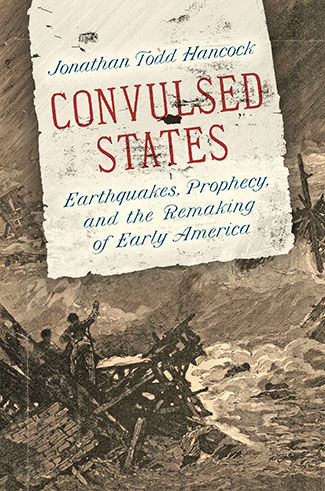 CONWAY, Ark. (April
7, 2021) – Imagine living in middle America in the early 1800s when a series of
earthquakes disrupts everyday life. How does this literally earth-shaking event
affect you, your community, and the spiritual and political forces already at
work before the ground began to tremble?
CONWAY, Ark. (April
7, 2021) – Imagine living in middle America in the early 1800s when a series of
earthquakes disrupts everyday life. How does this literally earth-shaking event
affect you, your community, and the spiritual and political forces already at
work before the ground began to tremble?
Dr. Jonathan
Hancock, associate professor of history at Hendrix College, examines these topics
in his new book, Convulsed States: Earthquakes, Prophecy, and the
Remaking of Early America (University of North Carolina Press).
The earthquake
activity of 1811–12, based in and around the Missouri Bootheel along the New
Madrid Fault, included the strongest quakes the region had experienced in at
least 500 years.
“Especially
closer to the epicenters, the magnitude of the shaking and extent of the damage
really shocked eyewitnesses,” Hancock says. “Readers of U.S. newspapers along
the East Coast also couldn’t believe stories about the Mississippi River
flowing backwards or people disappearing in crevices.”
Hancock spent 14
years studying archives across the country to learn how people from a variety
of backgrounds, locations, and perspectives struggled to understand, explain,
and react to the seemingly unprecedented natural phenomena—and how their
various interpretations affected the political and religious systems of their
time.
“I made some
surprising new archival discoveries, including evidence that a Native American
prophet foretold the earthquakes four years prior, and that U.S. disaster
relief legislation played a role in the establishment of Little Rock and the
concurrent dispossession of the Quapaw Nation,” Hancock said.
 Hancock offers
insights into the relationship between religious and political authority across
Native nations and the United States in the early 19th century. His examination
of the earthquakes spans different historical fields, shedding light on a
pivotal time in North American history that was influenced by nature’s display
of power in the area where Arkansas, Missouri, and Tennessee meet.
Hancock offers
insights into the relationship between religious and political authority across
Native nations and the United States in the early 19th century. His examination
of the earthquakes spans different historical fields, shedding light on a
pivotal time in North American history that was influenced by nature’s display
of power in the area where Arkansas, Missouri, and Tennessee meet.
“This was a time
of great religious revivalism, not only in the United States, but across the
Creek and Cherokee Nations, as well as among Native American communities in
the Ohio Valley,” Hancock said. “In the trans-Appalachian West, Methodist and
Baptist church rolls swelled after the earthquakes, and Native American and
Euro American prophets alike situated the earthquakes prominently in bids to
remake their respective nations.”
By considering
varied peoples’ efforts to understand and deal with the New Madrid earthquakes,
Convulsed States illuminates a natural and cultural climate that
required inhabitants to wrestle with fundamental human questions relating to
war, governance, and spiritual beliefs and authority.
The book
includes maps by Hendrix alumna Jasmine Zandi ’20, who used mapmaking skills
learned in a Geographic Information Systems [GIS] course at Hendrix taught by
Dr. Brett Hill.
About Hendrix College
A private liberal arts college in Conway, Arkansas, Hendrix
College consistently earns recognition as one of the country’s leading liberal
arts institutions, and is featured in Colleges That Change Lives: 40
Schools That Will Change the Way You Think About Colleges. Its academic
quality and rigor, innovation, and value have established Hendrix as a fixture
in numerous college guides, lists, and rankings. Founded in 1876, Hendrix has
been affiliated with the United Methodist Church since 1884. To learn more,
visit www.hendrix.edu.